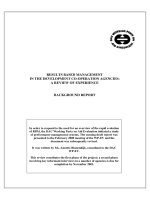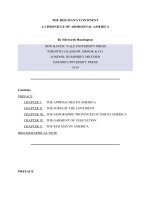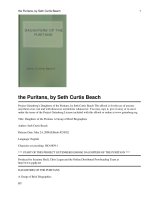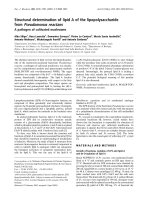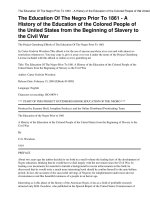How Is the Ku Klux Klan Like a Group of Real-Estate Agents
Bạn đang xem bản rút gọn của tài liệu. Xem và tải ngay bản đầy đủ của tài liệu tại đây (1.3 MB, 30 trang )
2
How Is the Ku Klux Klan Like a
Group of Real-Estate Agents?
As institutions go, the Ku Klux Klan has had a markedly up-and-
down history. It was founded in the immediate aftermath of the Civil
War by six former Confederate soldiers in Pulaski, Tennessee. The six
young men, four of whom were budding lawyers, saw themselves as
merely a circle of like-minded friends. Thus the name they chose,
“kuklux,” a slight mangling of kuklos, the Greek word for “circle.” In
the beginning, their activities were said to be harmless midnight
pranks—for instance, riding horses through the countryside while
draped in white sheets and pillowcase hoods. But soon the Klan
evolved into a multistate terrorist organization designed to frighten
and kill emancipated slaves. Among its regional leaders were five for-
mer Confederate generals; its staunchest supporters were the planta-
tion owners for whom Reconstruction posed an economic and
political nightmare. In 1872, President Ulysses S. Grant spelled out
for the House of Representatives the true aims of the Ku Klux Klan:
“By force and terror, to prevent all political action not in accord with
FREAKONOMICS
the views of the members, to deprive colored citizens of the right to
bear arms and of the right of a free ballot, to suppress the schools in
which colored children were taught, and to reduce the colored people
to a condition closely allied to that of slavery.”
The early Klan did its work through pamphleteering, lynching,
shooting, burning, castrating, pistol-whipping, and a thousand forms
of intimidation. They targeted former slaves and any whites who sup-
ported the blacks’ rights to vote, acquire land, or gain an education.
But within barely a decade, the Klan had been extinguished, largely
by legal and military interventions out of Washington, D.C.
If the Klan itself was defeated, however, its aims had largely been
achieved through the establishment of Jim Crow laws. Congress,
which during Reconstruction had been quick to enact measures of
legal, social, and economic freedom for blacks, just as quickly began
to roll them back. The federal government agreed to withdraw its oc-
cupation troops from the South, allowing the restoration of white
rule. In Plessy v. Ferguson, the U.S. Supreme Court gave the go-ahead
to full-scale racial segregation.
The Ku Klux Klan lay largely dormant until 1915, when D. W.
Griffith’s film The Birth of a Nation (originally titled The Clansman)
helped spark its rebirth. Griffith presented the Klan as crusaders for
white civilization itself, and as one of the noblest forces in American
history. The film quoted a line from A History of the American People,
written by a renowned historian: “At last there had sprung into exis-
tence a great Ku Klux Klan, a veritable empire of the South, to protect
the Southern country.” The historian in question was U.S. president
Woodrow Wilson, onetime scholar and president of Princeton Uni-
versity.
By the 1920s, a revived Klan claimed eight million members. This
time around, the Klan was not confined to the South but ranged
throughout the country; this time, it concerned itself not only with
50
The Ku Klux Klan and Real-Estate Agents
blacks but also with Catholics, Jews, communists, unionists, immi-
grants, agitators, and other disrupters of the status quo. In 1933, with
Hitler ascendant in Germany, Will Rogers was the first to draw a line
between the new Klan and the new threat in Europe: “Papers all state
Hitler is trying to copy Mussolini,” he wrote. “Looks to me like it’s
the Ku Klux that he is copying.”
The onset of World War II and a number of internal scandals once
again laid the Klan low. Public sentiment turned against the Klan as
the unity of a country at war trumped its message of separatism.
But within a few years, there were already signs of a massive revival.
As wartime anxiety gave way to postwar uncertainty, Klan member-
ship flourished. Barely two months after V-J Day, the Klan in Atlanta
burned a 300-foot cross on the face of Stone Mountain, site of a sto-
ried rock carving of Robert E. Lee. The extravagant cross burning,
one Klansman later said, was intended “just to let the niggers know
the war is over and that the Klan is back on the market.”
Atlanta had by now become Klan headquarters. The Klan was
thought to hold great sway with key Georgia politicians, and its Geor-
gia chapters were said to include many policemen and sheriff’s
deputies. Yes, the Klan was a secret society, reveling in passwords and
cloak-and-dagger ploys, but its real power lay in the very public fear
that it fostered, exemplified by the open secret that the Ku Klux Klan
and the law-enforcement establishment were brothers in arms.
Atlanta—the Imperial City of the KKK’s Invisible Empire, in Klan
jargon—was also home to Stetson Kennedy, a thirty-year-old man
with the bloodlines of a Klansman but a temperament that ran op-
posite. He came from a good southern family which claimed ances-
tors including two signers of the Declaration of Independence, an
officer in the Confederate Army, and John B. Stetson, founder of the
famed hat company and the man for whom Stetson University was
named.
51
FREAKONOMICS
Stetson Kennedy grew up in a fourteen-room house in Jackson-
ville, Florida, the youngest of five children. His uncle Brady was a
Klansman. But Kennedy would go on to become a self-described “dis-
sident at large,” writing numberless articles and several books that
railed against bigotry. He first worked as a folklorist, traveling around
Florida to collect old native tales and songs. Years later, when he
served as a rare white correspondent for the Pittsburgh Courier, the
country’s largest black newspaper, he wrote under the pseudonym
Daddy Mention—after a black folk hero who, as myth told it, could
outrun the blast of a sheriff’s shotgun.
What drove Kennedy was a hatred of small-mindedness, igno-
rance, obstructionism, and intimidation—which, in his view, were
displayed by no organization more proudly than the Ku Klux Klan.
Kennedy saw the Klan as the terrorist arm of the white establishment
itself. This struck him as an intractable problem, for a variety of rea-
sons. The Klan was in cahoots with political, business, and law-
enforcement leaders. The public was frightened and felt powerless to
act against the Klan. And the few anti-hate groups that existed at the
time had little leverage or even information about the Klan. “Almost
all of the things written on the subject were editorials, not exposés,”
Kennedy would later explain. “The writers were against the Klan, all
right, but they had precious few inside facts about it.”
So Kennedy set out to gather those facts. He would spend years
interviewing Klan leaders and sympathizers, sometimes taking ad-
vantage of his own background and lineage to pretend that he was
on their side of the issues. He also attended public Klan events and,
as he would later write, he even set about to infiltrate the Klan in
Atlanta.
The Klan Unmasked, Kennedy’s memoir of his exploits “inside” the
Klan, is in fact more of a novelization than a straight nonfiction ac-
count. Kennedy, a folklorist at heart, apparently wanted to put across
52
The Ku Klux Klan and Real-Estate Agents
the most dramatic story possible, and therefore included not only his
own anti-Klan activities but those of another man, code-named John
Brown. Brown was a union worker and a former Klan official who
had changed his ways and offered to infiltrate the Klan. It was John
Brown who apparently performed many of the most dramatic and
dangerous episodes portrayed in The Klan Unmasked—physically at-
tending Klan meetings and other functions in Atlanta—but since
Stetson Kennedy was the man who later wrote the book, he rendered
Brown’s actions as his own.
Regardless, there was a great deal of information to be gleaned
from this Brown/Kennedy collaboration. Brown divulged what he
was learning at the weekly Klan meetings: the identities of the Klan’s
local and regional leaders; their upcoming plans; the Klan’s current
rituals, passwords, and language. It was Klan custom, for instance, to
append a Kl to many words. (Thus would two Klansmen hold a Klon-
versation in the local Klavern.) The secret Klan handshake was a left-
handed, limp-wristed fish wiggle. When a traveling Klansman
wanted to locate brethren in a strange town, he would ask for a “Mr.
Ayak”—“Ayak” being code for “Are You a Klansman?” He would
hope to hear this response: “Yes, and I also know a Mr. Akai”—code
for “A Klansman Am I.”
Before long, John Brown was invited to join the Klavaliers, the
Klan’s secret police and “flog squad.” For an infiltrator, this posed a
particularly sticky problem: What would happen if he were called
upon to inflict violence?
But as it happened, a central tenet of life in the Klan—and of ter-
rorism in general—is that most of the threatened violence never goes
beyond the threat stage.
Consider lynching, the Klan’s hallmark sign of violence. Here,
compiled by the Tuskegee Institute, are the decade-by-decade statis-
tics on the lynching of blacks in the United States:
53
FREAK ONOMIC S
Y
EARS
L
YNCHINGS OF
B
LACKS
1890–1899 1,111
1900–1909 791
1910–1919 569
1920–1929 281
1930–1939 119
1940–1949 31
1950–1959 6
1960–1969 3
Bear in mind that these figures represent not only lynchings attrib-
uted to the Ku Klux Klan but the total number of reported lynchings.
The statistics reveal at least three noteworthy facts. The first is the ob-
vious decrease in lynchings over time. The second is the absence of a
correlation between lynchings and Klan membership: there were ac-
tually more lynchings of blacks between 1900 and 1909, when the
Klan was dormant, than during the 1920s, when the Klan had mil-
lions of members—which suggests that the Ku Klux Klan carried out
far fewer lynchings than is generally thought.
Third, relative to the size of the black population, lynchings were
exceedingly rare. To be sure, one lynching is one too many. But by the
turn of the century, lynchings were hardly the everyday occurrence
that they are often considered in the public recollection. Compare the
281 victims of lynchings in the 1920s to the number of black infants
who were dying at that time as a result of malnutrition, pneumonia,
diarrhea, and the like. As of 1920, about 13 out of every 100 black
children died in infancy, or roughly 20,000 children each year—com-
pared to 28 people who were lynched in a year. As late as 1940, about
10,000 black infants died each year.
What larger truths do these lynching figures suggest? What does
it mean that lynchings were relatively rare and that they fell pre-
54
The Ku Klux Klan and Real-Estate Agents
cipitously over time, even in the face of a boom in Klan member-
ship?
The most compelling explanation is that all those early lynchings
worked. White racists—whether or not they belonged to the Ku Klux
Klan—had through their actions and their rhetoric developed a
strong incentive scheme that was terribly clear and terribly frighten-
ing. If a black person violated the accepted code of behavior, whether
by talking back to a bus driver or daring to try to vote, he knew he
might well be punished, perhaps by death.
So it may be that by the mid-1940s, when Stetson Kennedy was
trying to bust up the Klan, it didn’t really need to use as much vio-
lence. Many blacks, having long been told to behave like second-class
citizens—or else—simply obliged. One or two lynchings went a long
way toward inducing docility among even a large group of people, for
people respond strongly to strong incentives. And there are few in-
centives more powerful than the fear of random violence—which, in
essence, is why terrorism is so effective.
But if the Ku Klux Klan of the 1940s wasn’t uniformly violent,
what was it? The Klan that Stetson Kennedy wrote about was in fact a
sorry fraternity of men, most of them poorly educated and with poor
prospects, who needed a place to vent—and an excuse for occasion-
ally staying out all night. That their fraternity engaged in quasi-
religious chanting and oath taking and hosanna hailing, all of it top
secret, made it that much more appealing.
Kennedy also found the Klan to be a slick money-making opera-
tion, at least for those near the top of the organization. Klan leaders
had any number of revenue sources: thousands of dues-paying rank-
and-file members; business owners who hired the Klan to scare off the
unions or who paid the Klan protection money; Klan rallies that
generated huge cash donations; even the occasional gunrunning or
moonshine operation. Then there were rackets like the Klan’s Death
55
FREAKONOMICS
Benefit Association, which sold insurance policies to Klan members
and accepted only cash or personal checks made out to the Grand
Dragon himself.
And, even though the Klan may not have been as deadly as gener-
ally thought, it was plenty violent and, perhaps worse, had ever
greater designs on political influence. Kennedy was therefore eager to
damage the Klan in any way he could. When he heard about Klan
plans for a union-busting rally, he fed the information to a union
friend. He passed along Klan information to the assistant attorney
general of Georgia, an established Klan buster. After researching the
Klan’s corporate charter, Kennedy wrote to the governor of Georgia
suggesting the grounds upon which the charter should be revoked:
the Klan had been designated a non-profit, non-political organiza-
tion, but Kennedy had proof that it was clearly devoted to both prof-
its and politics.
The problem was that most of Kennedy’s efforts weren’t producing
the desired effect. The Klan was so entrenched and broad-based that
Kennedy felt as if he were tossing pebbles at a giant. And even if he
could somehow damage the Klan in Atlanta, the hundreds of other
chapters around the country would go untouched.
Kennedy was supremely frustrated, and out of this frustration was
born a new strategy. He had noticed one day a group of young boys
playing some kind of spy game in which they exchanged silly secret
passwords. It reminded him of the Klan. Wouldn’t it be nice, he
thought, to get the Klan’s passwords and the rest of its secrets into the
hands of kids all across the country—and their parents too? What
better way to defang a secret society than to make public its most
secret information? Instead of futilely attacking the Klan from the
outside, what if he could somehow unleash all the secret inside
information that John Brown was gathering from the Klan’s weekly
meetings? Between Brown’s inside dope and everything that Kennedy
56
The Ku Klux Klan and Real-Estate Agents
had learned via his own investigations, he probably knew more Klan
secrets than the average Klansman.
Kennedy turned to the most powerful mass medium of his day:
radio. He began feeding Klan reports to the journalist Drew Pearson,
whose Washington Merry-Go-Round program was heard by millions of
adults every day, and to the producers of the Adventures of Superman
show, which reached millions of children each night. He told them
about Mr. Ayak and Mr. Akai, and he passed along overheated pas-
sages from the Klan’s bible, which was called the Kloran. (Kennedy
never did learn why a white Christian supremacist group would give
its bible essentially the same name as the most holy book of Islam.)
He explained the role of Klan officers in any local Klavern: the Klaliff
(vice president), Klokard (lecturer), Kludd (chaplain), Kligrapp (sec-
retary), Klabee (treasurer), Kladd (conductor), Klarogo (inner guard),
Klexter (outer guard), the Klokann (a five-man investigative commit-
tee), and the Klavaliers (whose leader was called Chief Ass Tearer). He
spelled out the Klan hierarchy as it proceeded from the local to the na-
tional level: an Exalted Cyclops and his twelve Terrors; a Great Titan
and his twelve Furies; a Grand Dragon and his nine Hydras; and the
Imperial Wizard and his fifteen Genii. And Kennedy passed along all
the information and gossip that John Brown gleaned by infiltrating
the main Klan chapter, Nathan Bedford Forrest Klavern No. 1, At-
lanta, Realm of Georgia.
During the war, the Adventures of Superman program had por-
trayed its hero fighting Hitler and Mussolini and Hirohito. But now
he was in need of fresh villains. The Klan was a perfect target, and Su-
perman turned his powers against them. Drew Pearson, an avowed
Klan hater, now began giving regular Klan updates on his radio show,
and then gave further updates, based on John Brown’s inside reports,
to show how the original updates were infuriating Klan officials.
Pearson’s work created an echo chamber that seemed to be driving
57
FREAKONOMICS
Grand Dragon Samuel Green crazy. Here is Pearson’s radio report
from November 17, 1948:
Speaking at Klavern No. 1, Atlanta, Ga., the week after elec-
tions, the Grand Dragon wrung his hands and once again cau-
tioned Klansmen to be careful about leaks.
“I have to talk frankly at these meetings,” he said, “but I
might as well call Drew Pearson before I come to the meeting
and give him the information, for [the] next day he gives it
out to everybody from coast to coast. The A.P. and U.P. are
both calling me about it next morning while I am eating break-
fast.”...
The Grand Dragon spoke about plans for a big cross-
burning to be held in Macon, Ga., on Dec. 10. It would be the
biggest in Klan history, he said, and he expected 10,000 Klans-
men to be there—in their robes....
He added that the Klavalier Klub—the Klan’s whipping and
flogging department—was now on the job and had plenty of
friends on the Atlanta police force.
As the Pearson and Superman radio shows played on, and as Stet-
son Kennedy continued to relay the Klan secrets obtained by John
Brown to other broadcast and print outlets, a funny thing happened:
attendance at Klan meetings began to fall, as did applications for
new membership. Of all the ideas that Kennedy had thought up to
fight bigotry, this campaign was easily the cleverest. He turned the
Klan’s secrecy against itself by making its private information public;
he converted heretofore precious knowledge into ammunition for
mockery.
Americans who might have been philosophically inclined to op-
pose the Klan had now been given enough specific information to
58
The Ku Klux Klan and Real-Estate Agents
oppose them more actively, and public sentiment began to shift.
Americans who might have been philosophically inclined to embrace
the Klan had now been given all sorts of caution against doing so. Al-
though the Klan would never quite die, especially down south—
David Duke, a smooth-talking Klan leader from Louisiana, mounted
substantive bids for the U.S. Senate and other offices—it was cer-
tainly handicapped, at least in the short term, by Kennedy’s brazen
dissemination of inside information. While it is impossible to tease
out the exact impact that his work had on the Klan, many people have
given him a great deal of credit for damaging an institution that was
in grave need of being damaged.
This did not come about because Stetson Kennedy was courageous
or resolute or unflappable, even though he was all of these. It hap-
pened because he understood the raw power of information. The Ku
Klux Klan—much like politicians or real-estate agents or stockbro-
kers—was a group whose power was derived in large part from the fact
that it hoarded information. Once that information falls into the
wrong hands (or, depending on your point of view, the right hands),
much of the group’s advantage disappears.
In the late 1990s, the price of term life insurance fell dramatically.
This posed something of a mystery, for the decline had no obvious
cause. Other types of insurance, including health and automobile and
homeowners’ coverage, were certainly not falling in price. Nor had
there been any radical changes among insurance companies, insur-
ance brokers, or the people who buy term life insurance. So what hap-
pened?
The Internet happened. In the spring of 1996, Quotesmith.com
became the first of several websites that enabled a customer to com-
pare, within seconds, the price of term life insurance sold by dozens of
59
FREAKONOMICS
different companies. For such websites, term life insurance was a per-
fect product. Unlike other forms of insurance—especially whole life
insurance, which is a far more complicated financial instrument—
term life policies are fairly homogeneous: any given thirty-year, guar-
anteed policy for $1 million is essentially identical to the next. So
what really matters is the price. Shopping around for the cheapest
policy, a process that had been convoluted and time-consuming, was
suddenly made simple. With customers able to instantaneously find
the cheapest policy, the more expensive companies had no choice but
to lower their prices. Suddenly customers were paying $1 billion less a
year for term life insurance.
It is worth noting that these websites only listed prices; they didn’t
even sell the policies. So it wasn’t really insurance they were peddling.
Like Stetson Kennedy, they were dealing in information. (Had the In-
ternet been around when Kennedy was attacking the Klan, he proba-
bly would have been blogging his brains out.) To be sure, there are
differences between exposing the Ku Klux Klan and exposing insur-
ance companies’ high premiums. The Klan trafficked in secret infor-
mation whose secrecy engendered fear, while insurance prices were
less a secret than a set of facts dispensed in a way that made com-
parisons difficult. But in both instances, the dissemination of the in-
formation diluted its power. As Supreme Court Justice Louis D.
Brandeis once wrote, “Sunlight is said to be the best of disinfectants.”
Information is a beacon, a cudgel, an olive branch, a deterrent—all
depending on who wields it and how. Information is so powerful that
the assumption of information, even if the information does not actu-
ally exist, can have a sobering effect. Consider the case of a one-day-
old car.
The day that a car is driven off the lot is the worst day in its life, for
it instantly loses as much as a quarter of its value. This might seem
absurd, but we know it to be true. A new car that was bought for
$20,000 cannot be resold for more than perhaps $15,000. Why? Be-
60




